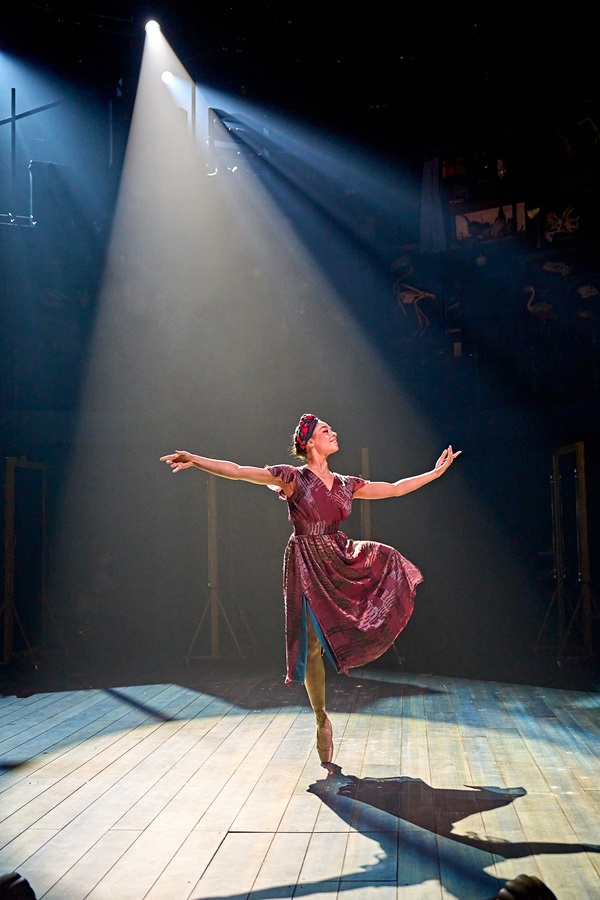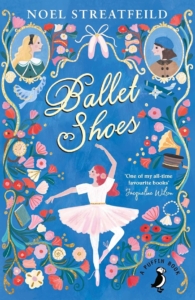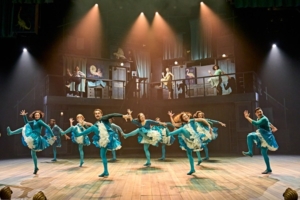
Ballet Shoes on stage
Nicolette Jones reviews the National Theatre’s production of Noel Streatfeild’s much-loved children’s classic.
 Noel Streatfeild’s 1936 children’s book, Ballet Shoes, was immediately a success and has never been out of print. She wrote it when she was 39, after working in a hospital kitchen during the First World War, training at RADA and acting for 10 years, and then writing, to begin with, for adults; Ballet Shoes was the first of her 80 books for children. Its strengths, the prose aside, included the unconventionality of the household it describes, the scrupulous account from her own experience of actors’ and dancers’ training, rehearsals and craft, and its clear-eyed examination of the ups and downs of sisterhood and the compromises enforced by poverty. All of which have a timelessness that helps to account for its durability.
Noel Streatfeild’s 1936 children’s book, Ballet Shoes, was immediately a success and has never been out of print. She wrote it when she was 39, after working in a hospital kitchen during the First World War, training at RADA and acting for 10 years, and then writing, to begin with, for adults; Ballet Shoes was the first of her 80 books for children. Its strengths, the prose aside, included the unconventionality of the household it describes, the scrupulous account from her own experience of actors’ and dancers’ training, rehearsals and craft, and its clear-eyed examination of the ups and downs of sisterhood and the compromises enforced by poverty. All of which have a timelessness that helps to account for its durability.
The new National Theatre adaptation, already acclaimed and running until 22 February, has a witty script by Kendall Feaver who has so far won half a dozen awards in her ten-year career. It makes quite free with Streatfeild, while preserving the central fact that three girls, adopted separately as babies by an eccentric scientist and explorer who comes to be known as Gum (Great Uncle Matthew), are sent to his home on the Cromwell Road to be brought up in his absence by his great niece Sylvia (herself still a child), a nanny, and later some random lodgers. Called after the rest of the professor’s collection, the three Miss Fossils (Pauline, Petrova and Posy) share a vow that their names will be remembered, go to stage school, grow close, and find their vocation in life.
The most conspicuous deviation from the book is that the siblings seem to be more or less of an age. Posy, the latest arrival, is not the  irritating little sister. Well, a bit irritating but not particularly because she is little – a change that allows for the sophisticated demonstration of her dancing skills. The play maintains some of the moral complexity of the book, though – Pauline for instance, still has to learn a lesson about letting her acting talent to go to her head.
irritating little sister. Well, a bit irritating but not particularly because she is little – a change that allows for the sophisticated demonstration of her dancing skills. The play maintains some of the moral complexity of the book, though – Pauline for instance, still has to learn a lesson about letting her acting talent to go to her head.
Nana, whose forceful character sits under a layer of propriety in Streatfeild’s text, has had her part built. Her outspokenness leads to some of the best comic lines.
The lodgers meanwhile have been whittled down, at least in quantity. The two doctors who tutor the girls have become one, who responds candidly to Pauline’s question: ‘Are you a lesbian?’ She is, and grieving her late love. This makes explicit what Streatfeild left us to infer about her two cohabiting women.
In the book Mr Robinson, who has a car and, to Petrova’s even greater delight, a garage, also lodges in the Cromwell Road house, along with his kindly wife. He nurtures Petrova’s ambitions to be a mechanic and an airline pilot. On stage Mr Robinson has become young, single, and Jai Saran, of Asian heritage, which enables a whole new plot strand. In the book his understanding and encouragement of Petrova is all-important. In the play he is also the romantic interest for Sylvia (aka Garnie), as a grown up.
One theme of the book is underlined by the diverse casting – that family can be the people we choose for ourselves. The unlikely household of rootless or displaced adoptees and guardians, lodgers and carers bond over the course of the show until they all belong to each other.
 We lose some of the details from the book about making ends meet and repurposing clothes. But what is added is the theatricality, and that is a joy. This includes the set: floor-to-ceiling cubbyholes containing fossils and bones collected by Gum; the ballet classes in which some of the little girls in tutus are acted by grown men; the musicians playing live; the costumes, including those Nana disapproves of for an avant-garde play. Actors show their skills in multiple parts, and certain imperious grandes dames are played cross-gender. There is entertaining stage business – including a beautifully timed tossed bouquet. As the audience arrives, the cast in tutus (and some moustaches) does barre exercises on the auditorium’s handrails. Although this production delights adults, it also has child-friendly features, down to the programme which contains quizzes, activities, and pictures of the actors as children. The duration: 2 hours and 45 minutes, might be less child-friendly, but the pace, humour, music, and dance mean there is plenty to entrance fidgeters. Not least the wow features: a swing
We lose some of the details from the book about making ends meet and repurposing clothes. But what is added is the theatricality, and that is a joy. This includes the set: floor-to-ceiling cubbyholes containing fossils and bones collected by Gum; the ballet classes in which some of the little girls in tutus are acted by grown men; the musicians playing live; the costumes, including those Nana disapproves of for an avant-garde play. Actors show their skills in multiple parts, and certain imperious grandes dames are played cross-gender. There is entertaining stage business – including a beautifully timed tossed bouquet. As the audience arrives, the cast in tutus (and some moustaches) does barre exercises on the auditorium’s handrails. Although this production delights adults, it also has child-friendly features, down to the programme which contains quizzes, activities, and pictures of the actors as children. The duration: 2 hours and 45 minutes, might be less child-friendly, but the pace, humour, music, and dance mean there is plenty to entrance fidgeters. Not least the wow features: a swing  that comes out over the audience. And an actual car that a child drives, on a nail-biting journey.
that comes out over the audience. And an actual car that a child drives, on a nail-biting journey.
Above all, this production makes the most of a novel that revelled in the business of performance. It celebrates its own art and artifice, and, right up to the hilariously bathetic last line, invites the audience to revel in it too. Noel Streatfeild would have appreciated the reverence paid to her work, with no loss of liveliness.
Nicolette Jones writes about children’s books for the Sunday Times and is the author of The Illustrators: Raymond Briggs (Thames & Hudson); The American Art Tapes: Voices of Twentieth Century Art (Tate Publishing) and Writes of Passage: Words to Read Before You Turn 13 (Nosy Crow).





